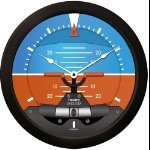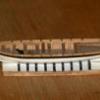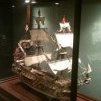Supplies of the Ship Modeler's Handbook are running out. Get your copy NOW before they are gone! Click on photo to order.
×
-
Posts
8,149 -
Joined
-
Last visited
Reputation Activity
-
 allanyed got a reaction from thibaultron in How was a ship's launch boat prepped to sail?
allanyed got a reaction from thibaultron in How was a ship's launch boat prepped to sail?
Kev,
Your questions are great and I am very curious to see the answers posted based on contemporary information. If you rig your launch model as a double lug sail boat like it is thought that Bligh rigged her, I don't think there is a bow sprit about which to worry which would not be the case if cutter rigged. I have been unable to find a contemporary drawing or model, so far, of a lug rig with a sprit. Perhaps if there are any detailed contemporary plans and/or models showing the rigging up close, that would help get an idea on how things were done. I for one am very interested to see if there are any rigging plans based on contemporary information.
Aside,,,, a golf buddy who works for BMW just spent two days driving three of the hottest Beamers around the Indy short track, full road course, and main track. He said it is really pretty country where you are and of course the driving was absolutely thrilling.
Allan
-
 allanyed got a reaction from bruce d in 2nd layer of hull plank installation question
allanyed got a reaction from bruce d in 2nd layer of hull plank installation question
If you look at the shape of the garboard strake on a plank expansion plan it may help you to shape the strake. While it tapers along its length in some cases, the key is for the forward end not to go too far up the rabbet at the stem. One example is https://www.rmg.co.uk/collections/objects/rmgc-object-83495 The upper is the ceiling planking and the lower is the hull planking.
Allan
-
 allanyed reacted to glbarlow in HMS Winchelsea 1764 by glbarlow - FINISHED - 1:48
allanyed reacted to glbarlow in HMS Winchelsea 1764 by glbarlow - FINISHED - 1:48
A milestone reached…..sorta.
1/3rd of one side of the hull complete….sorta.
The first light coat of WOP and these macro photos reveal additional touch up and additional sanding needed. The top half has more WOP coats. I’ll sand it all down with 800 grit at the end of my planking marathon. Still nice to complete something.
Lots of other June activities, she will have to be waiting for me for a while.
-
 allanyed got a reaction from Canute in Artistry and the Man-o-War
allanyed got a reaction from Canute in Artistry and the Man-o-War
Flyer, I agree that the Renaissance period was full of artistry in many ways, not just the works of Michelangelo and Da Vinci. It seemed to have carried over to vessels of most, if not all, seafaring nations including the two you mention. Whatever the reason, it is a wonder to see. Even the carvings on the contemporary models continue to amaze us.
Allan
-
 allanyed reacted to Glenn-UK in HMS Sphinx 1775 by Glenn-UK - FINISHED - Vanguard Models - 1:64 - V2 Kit by Glenn Shelton
allanyed reacted to Glenn-UK in HMS Sphinx 1775 by Glenn-UK - FINISHED - Vanguard Models - 1:64 - V2 Kit by Glenn Shelton
Foremast Take 2 - Update
Before I took the decision to remove the foreyard, due to the error I made in fitting the wrong sized double blocks for the jeers, I had tied off the brace threads to the spritsail top yard. I have not tied off the other end of these threads to their respective belaying point which will be done once the fore and preventor stays have been added. In the picture below I have used my reverse action tweezers to simulate tension on these braces.
With the truss pendants and jeer double blocks removed the foreyard is supported by the quad hands ready for the replacement truss pendants and jeer blocks to be added. I have also removed the pin as I wish to fit a slightly longer pin.
It did not take too long to fit the new jeer blocks and truss pendants. Once again I used clove hitch knots to secure the truss pendants.
The next picture gives a better idea of the truss pendant arrangement. One pendant is a short length with a thimble (eyelet) at the end. The other truss pendant the free end. Once the yard is pinned to the mast the free end is passed through the thimble and once pull tight to keep the yard in place it can then tied off using a simple half hitch knot. The knot is then secured with a touch of ca gel as I did not think it was feasible for me to add a proper seizing.
The foreyard (take 2) in place on the mast and looks good to my (wonky) eye. The foreyard booms have been removed for the time being.
Next I added the jeer rigging. It was so much easier with the right size blocks fitted to the foreyard and I am reasonably happy with how this looks. The free ends have been taken down to the deck but have not be tied off to their respective belaying points. I will adjust and tension the jeer rigging as necessary when it is time to belay the free ends.
Finally I made a start on adding the fore and preventor stays. After making a thimble on one end of the fore stay thread I did a trial fit and decided that the mouse needed to be position approx 8cm from the thimble. I added knotted thread on the stay at the 8cm point which will stop the mouse moving any close to the mast. The following picture shows this arrangement. Tomorrow I plan to add a 6mm closed heart block to the other end of the fore stay so it can be linked with the open heart of the bowsprit. I will then repeat the process for the preventor stay. I have not used a open / closed heart arrangement before as my previous builds have used deadeyes. I am not sure, as yet, how I can ensure the stays are tensioned when the lanyards are added but I am sure I will figure it out.
-
 allanyed got a reaction from yvesvidal in HMS Victory by drobinson02199 - FINISHED - Caldercraft - Scale 1:72
allanyed got a reaction from yvesvidal in HMS Victory by drobinson02199 - FINISHED - Caldercraft - Scale 1:72
I have found that is far easier to make the gratings first so there are no openings on the periphery then make the coamings and head ledges to fit around the gratings. They may be slightly off dimension wise from the plans, but they will look like those that you did so well on the lower deck.
Allan
-
 allanyed got a reaction from thibaultron in How was a ship's launch boat prepped to sail?
allanyed got a reaction from thibaultron in How was a ship's launch boat prepped to sail?
Great points across the board Roger. The only one that MAY be a problem is not taking the removable thwarts as then rowing at those stations would be problematic. I suppose the odd cask or other jury rig could be made, but an interesting point either way.
Allan
-
 allanyed got a reaction from Dave_E in Artistry and the Man-o-War
allanyed got a reaction from Dave_E in Artistry and the Man-o-War
Flyer, I agree that the Renaissance period was full of artistry in many ways, not just the works of Michelangelo and Da Vinci. It seemed to have carried over to vessels of most, if not all, seafaring nations including the two you mention. Whatever the reason, it is a wonder to see. Even the carvings on the contemporary models continue to amaze us.
Allan
-
 allanyed got a reaction from mtaylor in Artistry and the Man-o-War
allanyed got a reaction from mtaylor in Artistry and the Man-o-War
Flyer, I agree that the Renaissance period was full of artistry in many ways, not just the works of Michelangelo and Da Vinci. It seemed to have carried over to vessels of most, if not all, seafaring nations including the two you mention. Whatever the reason, it is a wonder to see. Even the carvings on the contemporary models continue to amaze us.
Allan
-

-
 allanyed reacted to flyer in Artistry and the Man-o-War
allanyed reacted to flyer in Artistry and the Man-o-War
Perhaps they thought, that of course only enemy ships would eventually resemble the proverbial Swiss cheese. To be shot at, that's what enemy ships were there for after all. Own ships would never get harmed.
Perhaps it started in the middle ages (Sovereign of the seas, Vasa) when kings wanted to intimidate their enemies with the sheer beauty and richness of their war machines to make them loose all confidence - not unlike the way the church in those times would try to impress poor countrymen with splendour and grandeur.
(BTW - there is only one of the about 15 most common sorts of Swiss cheese which has those proverbial holes.)
Peter
-
 allanyed got a reaction from yvesvidal in HMS Bellona by yvesvidal - FINISHED - CAF Model - 1:48
allanyed got a reaction from yvesvidal in HMS Bellona by yvesvidal - FINISHED - CAF Model - 1:48
I thought that might be the case. Nothing wrong with taking things into your own hands, so to speak. Your build log continues to be a joy to follow.
Allan
-
 allanyed got a reaction from mtaylor in How was a ship's launch boat prepped to sail?
allanyed got a reaction from mtaylor in How was a ship's launch boat prepped to sail?
Great points across the board Roger. The only one that MAY be a problem is not taking the removable thwarts as then rowing at those stations would be problematic. I suppose the odd cask or other jury rig could be made, but an interesting point either way.
Allan
-
 allanyed reacted to Mark m in Lowell Grand Banks Dory by Mark m - Model Shipways - 1:24 - FINISHED
allanyed reacted to Mark m in Lowell Grand Banks Dory by Mark m - Model Shipways - 1:24 - FINISHED
Dory Build Log Part 4 The remaining planks
The broad and sheer strakes are beveled, bent and attached similarly to the garboards.
When I went to trim the broad plank, I realized that my rolling bevel had missed the target. I had beveled it following the instructions, but hadn’t factored in the need to trim the board after it was glued down. As a result, my beautiful rolling bevel was trimmed off!
There is also a gap between the garboard and the broad plank. As best I can tell, this is caused by the indented garboard mentioned in my previous update. I filled it with dilute glue and hope to paint it over when the time comes.
Having learned my rolling bevel lesson on the first broad plank, I did a better job on the other side. The photo of the stern shows the difference.
The bow seemed quite ugly, but I took solace in the fact that the false stem will hide that.
The next four pictures show some creative clamping then the two sides of the boat.
And finally, the lack of symmetry at the stern transom. I don’t know how I managed to get so far off. I can see that the port side (right side in this picture) planks come at least a couple of millimeters higher than the starboard side. I guess I should have measured and marked the side of the transom to position the planks correctly. Any other tips on how to prevent this?
-
 allanyed reacted to Clementine in HMS Beagle by Clementine - OcCre - 1:60 Scale
allanyed reacted to Clementine in HMS Beagle by Clementine - OcCre - 1:60 Scale
carronade & forecastle is done. now to work on the well deck
-
 allanyed got a reaction from Jobbie in HM Brig Supply by Jobbie - Caldercraft - Scale 1:64
allanyed got a reaction from Jobbie in HM Brig Supply by Jobbie - Caldercraft - Scale 1:64
The Anatomy of Nelson's Ships book is fantastic and you are to be complimented for not using any information in the kit without verifying it first. But to know what applies and what does not would take hours of research to compare each item in a more complete book on rigging such as Lee's Masting and Rigging English Ships of War which covers a range of sizes and years. With the investment in money and time you have already made, Lees' book is a worthwhile incremental investment to consider for this project and future projects.
Allan
-
 allanyed got a reaction from EricWilliamMarshall in Polaris by ibozev - FINISHED - OcCre - 1:50
allanyed got a reaction from EricWilliamMarshall in Polaris by ibozev - FINISHED - OcCre - 1:50
Your following the tutorials for planking has resulted in one of the finest planking jobs in the kit build logs here at MSW. It can serve as a lesson to others that no one is relegated to using the erroneous methods shown by some kit makers where many the planks fail to end at the rabbet as they should.
With this being your first build, the build log is even more impressive.
Allan
-
 allanyed got a reaction from mtaylor in HMS Bellona by yvesvidal - FINISHED - CAF Model - 1:48
allanyed got a reaction from mtaylor in HMS Bellona by yvesvidal - FINISHED - CAF Model - 1:48
I thought that might be the case. Nothing wrong with taking things into your own hands, so to speak. Your build log continues to be a joy to follow.
Allan
-
 allanyed got a reaction from mtaylor in HMS Bellona by yvesvidal - FINISHED - CAF Model - 1:48
allanyed got a reaction from mtaylor in HMS Bellona by yvesvidal - FINISHED - CAF Model - 1:48
Hi Yves
The drawing from AOTS that you posted shows the rudder taper which was pretty normal. Does the kit and/or the book show the taper of the knee of the head from the stem moving forward which reduced by about half?
Thanks
Allan
-
 allanyed got a reaction from Old Collingwood in Santa Maria by Knocklouder - FINISHED - Amati - 1:65
allanyed got a reaction from Old Collingwood in Santa Maria by Knocklouder - FINISHED - Amati - 1:65
Hi Bob,
Hard to tell from your photo but the one block looks to be backwards such that the line will not roll over the would be sheave.
Allan
-
 allanyed reacted to French Mr Bean in SeaWatch Books is Open!
allanyed reacted to French Mr Bean in SeaWatch Books is Open!
Books received today!! A wonder.
The photos, plans, texts, book production, everything is fabulous!
To do: Ask a pc translator to help me (my poor English has already understood things...) and study the plans.
A big congratulations to the author, the publisher, and the delivery conditions (well packaged, 1 week to come to France)
I got my Christmas present early! 🤣
-
 allanyed got a reaction from scrubbyj427 in HMS Bellona by yvesvidal - FINISHED - CAF Model - 1:48
allanyed got a reaction from scrubbyj427 in HMS Bellona by yvesvidal - FINISHED - CAF Model - 1:48
Hi Yves
The drawing from AOTS that you posted shows the rudder taper which was pretty normal. Does the kit and/or the book show the taper of the knee of the head from the stem moving forward which reduced by about half?
Thanks
Allan
-
 allanyed got a reaction from EricWilliamMarshall in What's a good kit for learning rigging?
allanyed got a reaction from EricWilliamMarshall in What's a good kit for learning rigging?
Mark,
Good for you on the first builds! I would consider investing in a couple books as well as vetting which model to buy to be sure of the kit accuracy and some "how to" advice. A quick start is to look at the build logs and see what the various kits offer. Check little things such as if the kit offers cheap string instead of miniature rope, realistic looking blocks, realistically scaled belaying pins, accurate belaying points, etc. Once you have narrowed it down, post here and ask for opinions.
For details on actual rigging, Lees' Masting and Rigging English Ships of War is hard to beat. A lot of folks recommend Petersson's book Rigging Period Ship Models which unfortunately is limited in scope and gives no information on how to actually do anything. Then again, if you happen to be building a fifth rate vessel from about 1785, it will be very useful. For actual "how-to" practices, Volume IV of The Fully Framed Model series is helpful even though it is centered around Swan class vessels. Of course there are hundreds of pieces of great information here at MSW on how members do things that are extremely helpful for both what they have done that works and what they have done that does not work so well.
Allan
-
 allanyed got a reaction from mtaylor in Constellation by Weedboy 11 - Artesania Latina - 1:85
allanyed got a reaction from mtaylor in Constellation by Weedboy 11 - Artesania Latina - 1:85
Welcome to MSW. What name would you prefer to be called unless Weedboy 11 is what you want. I am sure there is an interesting story there. 😀 You might want to consider writing a post in the new member section and give a little background about yourself.
Welcome again, and good luck on your build!!
Allan
-
 allanyed got a reaction from tlevine in 2nd layer of hull plank installation question
allanyed got a reaction from tlevine in 2nd layer of hull plank installation question
If you look at the shape of the garboard strake on a plank expansion plan it may help you to shape the strake. While it tapers along its length in some cases, the key is for the forward end not to go too far up the rabbet at the stem. One example is https://www.rmg.co.uk/collections/objects/rmgc-object-83495 The upper is the ceiling planking and the lower is the hull planking.
Allan










.thumb.jpeg.fc5d633a7b34428fcf19419a73d56d55.jpeg)

